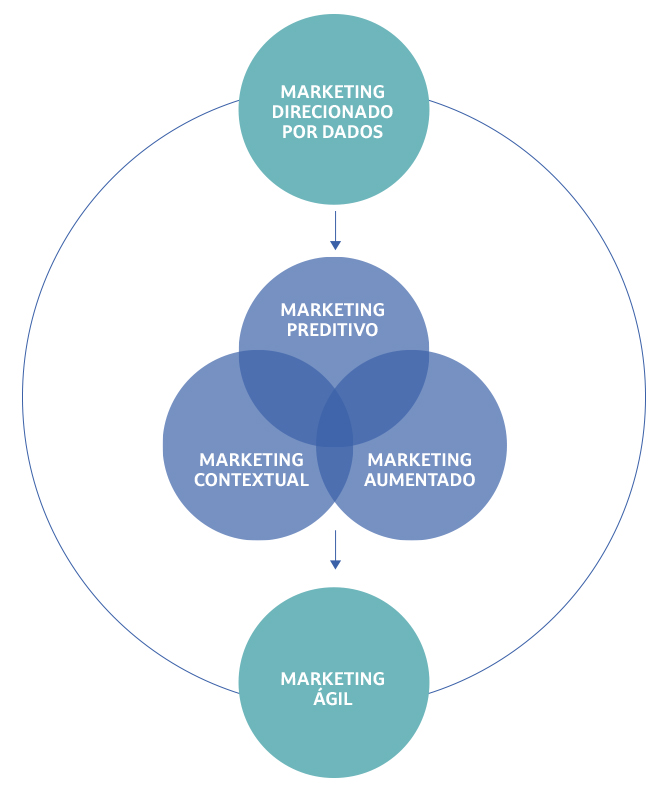For the first time in history, five generational groups coexist in the consumer market: the baby boomers, generations X, Y, Z and Alpha. Given this context, a major challenge faced by marketing professionals around the world is to understand the consumption behavior of these generations, and use these patterns to create products according to each need and desire.
Generational slice is one of the most basic and popular forms of market segmentation. The premise of this logic is that people who were born and raised in the same period experienced the same significant events and therefore share the same sociocultural experiences and are more likely to have the same set of values, attitudes and behavior.
As a result, each generation is shaped by a different environment and life experience. They also have their distinct preferences and attitudes towards products and services. Despite understanding their different needs, most companies are not well positioned to serve the next generation that will become part of their audience.
The selection of target markets also creates a dilemma, as most of the consumer power is tied to the brands that serve the baby boomers and generation X. On the other hand, in this same context, most of the value of brands is created when they are endorsed by Y and Z – with the factor of influence and digital knowledge. And, most importantly, Generations Y and Z are starting to influence parents baby boomers and Generation X in many purchasing decisions.
That said, understanding these groups is precisely serving different audiences in a personalized and assertive way. Companies need to find a balance between two objectives: maximizing value creation in the present and positioning their brands for the future gradually, with planning.
How the generations differ
First, it is necessary to understand the temporal cuts of each generation, since each one of them refers to those born in a certain interval of years.
- Generation baby boomers: born between 1946 and 1964 (currently aged 59 to 77)
- Generation X: born between 1965 and 1980 (currently aged 43 to 58)
- Y generation (millennials): born between 1981 and 1996 (currently aged 27 to 42)
- Generation Z: born between 1997 and 2009 (currently aged 14-26)
- Generation Alpha: born between 2010 and 2025 (currently up to 13 years old)
It is important to make some considerations about these divisions. These dates of birth vary greatly depending on the sources and there is no consensus on them. These are just trends that identify a large part of the group, but which cannot be generalized to all those born in these years.
baby boomers – an aging economic powerhouse
You baby boomers they are a generation born between 1946 and 1964, the post-World War II period. They were named so due to the significant increase in the birth rate during this period in the United States. This generation grew up in a time of great economic prosperity and technological advances, but also lived through important moments in history, such as the Cold War, the Vietnam War and the struggle for civil rights.
You baby boomers they are often associated with traditional values such as hard work, dedication to family and loyalty to the company. It is considered the generation that helped shape the modern world, being responsible for significant advances in areas such as technology, medicine and the achievement of civil rights. They were also the first people to grow up with television and advertising, which had a huge impact on their culture.
many concepts anti-establishment, such as social activism, environmentalism and the lifestyle hippie, emerged at that time. It is also the first generation to conquer the “right to be young” and the freedom to hit the road, listen to rock'n'roll and enjoy great music festivals — which inspires young people to this day!
Because of their sheer size and because of the postwar economic boom at the time they were growing, the “boomers”, as they are also called, became one of the greatest powers of the economy and entered the Brazilian job market in the 70s. Over several decades, they were the focus of marketing professionals, before being numerically separated from the Y generation.
Currently, because they have a longer and healthier life, they postpone retirement and prolong their professional career beyond the age of 65.
On the other hand, for the market, it is important to be aware that the boomers currently concentrate much of the consumption power and the main purchasing decision-making around the world, both in charge of countries and large companies. They are heavily criticized by younger generations for their lack of willingness to adopt new technologies. They also have a preference for brands that are already established in the market. In general, they don't like sudden changes in their lives.
Generation X – the middle children who lead
Generation X was born between 1965 and 1980 and grew up in a period of great social, political and technological changes. It is often associated with values such as independence, flexibility and adaptability. Here in Brazil, it was strongly marked by the repression of the civil-military dictatorship. Therefore, it does not have the same optimism as boomers.
Furthermore, Gen X flourished at a time when technology was advancing rapidly but not yet as ubiquitous as it is today. They remember a time when telephones were landlines and letters were the main means of communication. They grew up watching music videos on MTV and listening to cassette tapes on walkman. It was also the first group to experience the emergence of the Internet and the transition to the digital age. That is, from the rise and fall of movie rental companies, the rise of DVD to the arrival of streaming that we know today.
As a result, it is often described as a generation of problem solvers and entrepreneurs. They had to adapt to rapid changes in the job market and learn to deal with economic uncertainty. Many of them started their own businesses or sought more flexible work opportunities and, today, they represent a large part of entrepreneurs, including startups. According to the Federation of Industries of the State of São Paulo (Fiesp), 38% of Brazilian startups are from people over 45 years old.
Generation X is also often associated with a sense of irony and skepticism towards institutions and authorities. These people grew up during the punk rock and grunge era, and their pop culture reflected this attitude, therefore valuing diversity and inclusion, having grown up at a time when discussions of equality and civil rights were very pronounced.
Today, many Gen Xers are at the peak of their careers and are leaders in their industries, with an average work experience of 20 years. They are facing new challenges, such as balancing work and personal life, caring for aging parents and planning for retirement. However, Gen Xers continue to be a significant force in society and their influence is felt in many areas of modern life.
Generation Y – the millennials who ask “why?”
Generation Y has been the central discussion in recent years. Also known as millennials, is a generation born between the years 1981 and 1996. They grew up in a period of rapid technological and social change, often being described as a connected, collaborative and idealistic generation.
Millennials grew up in a more globalized and digital world than Millennials, with access to technologies such as the internet and smartphones from a very young age, they value instant communication and connecting with others, and many of them stand out for being highly proficient in technology.
As a result, it is often associated with values such as creativity and innovation. They are noted for their ability to think outside the box and find creative solutions to problems. Many of them are also entrepreneurs, looking for new ways of working and unconventional career opportunities.
One of the best-known studies on Generation Y was carried out by Box 1824, which points out that, with the arrival of millennials to the market, the desire to be young became an obsession. The survey points out that Generation Y has become a reference for younger people and an inspiration for older ones, thus demonstrating the high power of influence in their consumption over other people.
In Brazil, the millennials they were born in the context of re-democratization (post-civil-military dictatorship) and economic and political instability, later experiencing a moment of consolidation of these aspects, especially with the emergence and implementation of the Real Plan.
Generation Y also has in common the appreciation of diversity, inclusion and social justice. They grew up at a time when awareness of equality and civil rights is more present, see the experiences of the previous generation, and many of them are involved in voluntary activities and social causes.
Because of their higher educational attainment, diversity, and wide access to knowledge, Millennials are more open-minded and idealistic. She questions everything, which makes her more susceptible to conflict in the workplace with older generations who expect her to conform.
Millennials share stories of complicated professional environments. As a result, many found themselves creating their own companies. Thanks to this experience of strong competition at work, they tend to clearly separate their personal and professional lives.
Generation Z – the first digital natives
Now, more than ever, marketing is turning its attention to Gen Z. You may not have realized it, but Gen Y is already getting older, and marketing needs to get to know better the young people who are coming into the market and dictating behavior. of the brands.
Descendant of generation X, generation Z is born between 1997 and 2009. In the United States they are also known as centennials. They grew up in an even more connected and digital world than the Y, and are often described as a generation that values diversity, creativity and flexibility.
A large part of her witnessed the financial difficulties of her parents and older siblings, so she is more financially conscious in relation to Y. Tends to save money and consider financial stability as an essential factor in her career decisions.
Born when the internet had already become mainstream, are considered the first digital natives, as they grew up with smartphones, tablets and social media included in their routine from an early age. It is a generation that is always connected, ready to access information and communicate with others in real time. They continuously consume content across multiple screens, even on social occasions. What's more, they see no border between the Off and the online.
In Brazil, this generation is born at a time of prosperity, economic growth and the search for social justice. However, in their teens, they are already going through the political and economic crisis after the 2014 presidential elections. It is these teenagers who engage in movements to contest the government — either on one side or the other — and engage politically.
Therefore, they have a strong critical sense, which becomes striking in their identity. It is with this criticality that they see the crisis in Brazil, face the economic recession and seek answers to improve the country's situation, without running away from responsibility.
Empowered by social media, Generation Z records everyday life on their personal profiles in the form of photos and videos. However, unlike Y, which is idealistic, Z is pragmatic. While Y likes to post curated and filtered photos of themselves for personal marketing purposes, Gen Z prefers more authentic and real versions. Therefore, they repel brands that disseminate edited images that are too good to be true.
Like Generation Y, Generation Z is very concerned about social change and environmental sustainability, and gives preference to brands that share these values. In addition, she is passionate about making a difference through volunteering and expects her employers to provide platforms that allow her to do so.
According to a survey by the Think With Google, 85% of Gen Zers said they were willing to donate some of their time to a cause. Another interesting study on this group is from Box 1824, which points out that 63% from generation Z defends every cause linked to people's identity, that is, gender, ethnicity and sexual orientation, for example.
In addition, this generation has a very fluid identity. Don't try to define them or put them in boxes - they are whatever they want to be, in that moment, in that context. They are even more plural and dynamic than generation Y and, therefore, diversity and inclusion are concepts intrinsic to their identity and their conception of society.
Currently, generation Z already represents a numerically larger group than generation Y on the planet. In 2025, it will make up most of the workforce, thus becoming the most relevant consumer market for products and services.
Generation Alpha – the children of millennials
The Alpha generation is the youngest, born between the years between 2010 and 2025. They are children of parents from generations Y and Z. Name given by Mark McCrindle, the name based on the Greek alphabet represents an entirely new generation, which will be shaped by technological convergence. They are not just digital natives, they are strongly influenced by the behavior of their parents and older siblings. The launch of the first iPad marked the emergence of this generation in 2010.
The characteristics of the Alpha generation are largely shaped and influenced by the parenting style of the Generation Y parents. Having married at an older age, the Y place greater emphasis on raising and raising children. It also educates children about money and finances from an early age. It's a well-educated and tech-savvy group, but also inclusive and sociable.
This generation is born into a world where Artificial Intelligence (AI), automation, voice command and robotics are becoming more and more commonplace, which could have a big impact on their future.
Read too: What can companies learn from the new Artificial Intelligence (AI): ChatGPT and Bard?
In an interview with Grupo Padrão, Fernanda Furia, master in psychology of children and adolescents, says that the Alpha generation will be the protagonist of the beginning of an affective relationship between human beings and machines.
While Alphas are still very young, it's important to consider the impact this generation could have on the future. Today, they do not have great purchasing power, but they already have a strong influence on the spending of other generations. A Google search shows that, 74% from parents millennials include the Alpha generation children in household decisions. Another report from Wunderman Thompson points out that 55% of kids in the US and UK would like to buy things their influencers use. So it's only a matter of time before they become the global focus of marketers.
The life stages of the five generations
Understanding what is essential for the five generations requires analyzing the stages they go through during their lives. In general, there are four stages in human development, named Fundamental, Frontal, Fostering and Final. Each spans about 20 years, and as you move from one to the next, there is a significant change in your life's goals and priorities.
Fundamental: the focus is on learning. During the first 20 years of life, the individual is exploring the environment and adapting to it. Acquires knowledge and skills not only through formal instruction, but also through friendships and other social relationships. Stage of searching for one's own identity and for a reason for being.
Font: during the second 20-year period, the transition from learning to work begins, as you begin to earn a living and build a career. At this stage, health is at its peak, there is a greater willingness to take risks and enjoy life to the fullest. It is also at this stage that commitment to romantic relationships begins.
Promotion: the individual begins to stabilize and build a family. The tendency is to return to a healthier lifestyle after a period of increased stress. He also spends more time taking care of the evolution of others. At home, the focus is on parenting and family life in general. At work, the emphasis shifts to mentoring and training younger generations. Giving back to society becomes a key objective at this stage.
Final: the person tries to adapt to old age and stay happy. The main objective is to take care of declining health and social relationships. The focus becomes enjoying life, starting new activities that are rewarding and purposeful.
You baby boomers and Generation X have been following similar trajectories in their life cycles. Generation Y, on the other hand, has followed a more different trajectory. Its members reach traditional life milestones, such as marriage and the birth of children, at a more advanced age. It is a concession they make to reach goals earlier, especially in their professional careers. As a result, it progresses from one stage of life to another at a greater speed compared to other generations.
Generation Z and Alpha are also believed to have shorter life stages, adopting an earlier mature mindset as a result. These shorter life stages have profound consequences on the approach to marketing. Serving the Z and Alpha generations – the two most important of the next decade – is not just a matter of applying technologies, but using technology to enable human-centric solutions.
Read too: The 70 years of evolution of Marketing: from 1.0 to 5.0
These two younger generations will be catalysts for Marketing 5.0, which is an integration of Marketing 3.0 and Marketing 4.0. They are enormously concerned about how technology can empower happiness. Companies that are able to gain the trust of generation Z and Alpha will succeed in the competition of the Marketing 5.0 era
Reflection
Which generations does your company serve today? Do you fully understand their preferences and behaviors?
Is your company well positioned for the future? In other words, are you preparing your organization to serve digital natives – Gen Z and Gen Alpha?


























